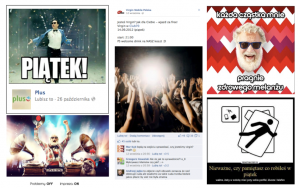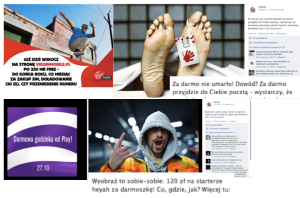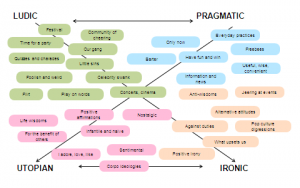By Krzysztof Polak, Semiotic Solutions
Social media continues to be a source of excitement and temptation. This week Facebook turns 12 years old, but it has yet to be analysed qualitatively in a satisfactory manner. A quantitative approach seems to be obvious – but while we are fascinated by statistics, we can say very little about the content, symbols, metaphors and narrations of Facebook i.e. everything that can be described as its language. What is the “grammar” of this language? What rules and principles does it follow? What style, language or visual conventions are binding in this area, and finally, to what meanings and contemporary cultural values do Facebook communications refer too?
An international telecoms corporation entrusted us with the task of analysing the Facebook communications of telecom brands. It was quite an experimental and unusual project. It was about a qualitative approach to Facebook, which would let us find linguistic and meaning mechanisms and codes, answer the question on how individual brands use codes, and thirdly identify what response individual types of codes and meanings generate.
We analysed the fansites of telecom brands such as Plus, Heyah, Orange, Heart and Mind, Play, T-Mobile, and Virgin. Prior to commencing a proper analysis, while browsing through Facebook sites, we noticed that the content posted was diverse and multi-threaded. We got the impression of chaos and haphazardness. Finding order, the deep structure underlying the multitude of content or the structure organizing everything posed a real challenge.
When approaching this type of analysis, the basic unit to be analysed had to be defined. For example, whether an independent analysis should cover photographs posted by moderators and fans, or content and the forms of sentences, or titles and headers, or rhetorical forms used by moderators to encourage visitors to post likes.
In the case of Facebook, without any doubt a post constitutes such “a brick”. A post is a certain unit, which combines an image and text. Moreover, most posts have a similar length – they consist of 2-3 short sentences at maximum. Posts usually include a header, which encourages visitors to read the rest. Our “brick” for analysis is therefore a form of a similar structure (syntagm), thanks to which it can be compared with others.
The next stage of the analysis consisted of collecting the right number of posts. We decided to analyse the posts, from each of the analysed sites, placed in the last three months. 1065 posts in total – a significant amount of material for qualitative analysis.
A semiotic analysis of the posts revealed a certain order, the basic structure underlying the fansites of telecom brands. The analyses of Jean Marie Floch – a semiotician from the Paris school of semiotics, who conducted a series of commercial analyses for the French branch of IPOSs in the 1970s and 1980s, were helpful here.
In his analyses of Renault’s communications Floch distinguished four main types of valorisation. These were:
- Practical valorisation – practical gains and benefits
- Utopian valorisation – romanticism, tenderness and soft nostalgia
- Ironic valorisation – coping with everyday reality
- Ludic valorisation – fun, play and amusing themes
When analysing individual posts and then combining them in groups, we noticed that the differentiation used by Floch enables us to structure the Facebook chaos. Despite the differences in the analysed matter – cars vs. telecom – similar communication mechanisms exist.
We noticed that the basic order of Facebook post codes is between practical and ludic codes. Hence, on one hand we had quite a considerable set of ludic codes – communicating fun, amusing themselves, and on the other hand – a set of pragmatic codes emphasising a practical gain, usefulness and price. Following in Floch’s footsteps subsequent conventions could also be noticed – utopian and ironic – thus creating a complete set of Facebook codes (in the area of telecom brands). The individual groups of codes will be discussed further in this article.
Ludic Codes
Posts referring to fun, play, as well as amusing and foolish pranks constituted a significant group. These posts were filled with humour, carefreeness and lightness. The trend to use pop culture content was clear. The moderators willingly reach for the topics and forms, which were to build a strong distinction between work/school and leisure time. The idea of “making it through to Friday” was a key characteristic.
The increasing popularity of what is foolish and weird, preposterously funny or ‘naff’ is evident. A wide range of charades and quizzes enjoyed enormous popularity – they enabled the audience to prove themselves and confirm it in comments to the post by suggesting their own solution. Celebrity themes or themes like “our happy gang” looked rather ‘stale’ against this background (residual).
We identified 11 code types in this group. An example is “time for a party”. It is quite a big group of posts using weekend expressions – exclamation marks, excitement cries “Friday! “, “weekend!”
They are accompanied by part-related information and preparations – a house party, a melange, a club party, a super party, a super fun, as well as post-party problems – how one managed to live through the weekend or the party, the consequences of a melange or ways of handling a hangover.
Expressive posts like “Friday!” or “every part of me craves for a healthy melange” got several thousand likes and 100-200 comments.
Pragmatic Codes
We found 7 code types in this group. The whole group refers to practicality, gains and convenience. Low prices, deals, favourable solutions and functionality are relevant aspects. The moderators used rational, logical language and also frequently posted to mask their advertising and sales activities. This was done by combining sales with elements of fun. However, the audience could very quickly expose such activities by allocating hates to specific posts.
An example can be the code, which we named “freebees”, which uses notions like “for free”, “gratis”, “we are handing things out for free”. For example, “free until the end of the year”, “for free did not die, for free will get to you by post”, “imagine 120 zlotys on your Heyah starter for free!”
Other codes from this group referred to one’s daily life practices, behaviours, and habits. Here, the moderators engaged the audience in discussions mainly by asking questions like “how do you do it?” “what do you take with you when you leave home”, “how long does it take you to get to work”, “which seats do you choose in the cinema”.
Utopian Codes
We found 8 code types in this group. They referred to values like happiness, love, and goodness. Positive life affirmations, naive idealism, honesty, and innocence were also visible.
The moderators often reached for naive and infantile photographs – dogs, cats, phones in knitted cases, cute Android-plush toys. This was accompanied by linguistic diminutives and endearments like “cutie”, “my little phone”, “sweetie”. Such posts received multiple, strong likes and positive comments. An example can be the code “naive and infantile”.
Ironic Codes
We found 7 code types in this group. They expressed the audience’s distance to the surrounding reality through the use of irony, pastiche, and mockery. They negated one’s duties and social norms. They indicated alternative attitudes and lifestyles.
Historically, ironic or sarcastic posts did not show on the fansites of telecom operators at all. Mainly because, at that time they were used by telecom brands as an information rather than emotion channel. At that time ironic codes mainly dominated the Facebook sites of Kwejk and Demotywatory.
A good example is the code, which we named “against duties”, which jeers at one’s duties and tasks – studies, work, going to school. It included posts like “Going to work? and “is there anything cool for you there?” or “time for studying? Sorry, I haven’t got any time”.
The final map of Facebook codes looks similar to this:
It is worth remembering here that describing Facebook language and distinguishing the key mechanisms and codes was not the research purpose in itself. With the map of codes at hand, another stage could be started – analysing individual brands. We asked ourselves a question, how telecom brands use individual codes and how this impacts their images.
For some telecom brands – unfortunately, due to confidentiality we may not disclose their names – we could see one predominant code type. For example, in the case of one brand 64% of all the posts belong to the group of pragmatic codes. The brand’s pragmatism also attracted users focusing on practical and direct gains, looking for bargains, expecting to get more and more. This also showed in their very practical approach to the brand and the low loyalty of communication recipients, as well as their frequent irritation that they do not get more, and their negative comments.
Certainly, there were no brands that would be consistent in using codes – there were always mixes of different code types, although codes from one particular group dominated in virtually every case.
An analysis of users’ response to specific codes was an independent part of the study. We were also interested to know which rhetorical techniques are used by moderators and what reactions they evoke. We identified the presence of the following forms: alternative questions, unfinished sentences, leading questions, confirming questions, apostrophes, etc. For example, alternative questions like “this or that” generated several thousand likes and prompted positive comments. Unfortunately, due to confidentiality a more detailed description of this analysis is impossible.
The semiotic Facebook analysis made it clear to us and our client that selecting one of the four methods of fansite communication i.e. ludic codes, pragmatic codes, utopian codes or ironic codes is a strategic decision for a brand. An uncontrolled mix in the form of “a bit of this and a bit of that” may cause a lot of harm and blurs the clear image of the brand.
Moreover, the analysis also enabled us to understand, how the images of individual brands are shaped through fansites and how they can be better controlled or directed through conscious management of post codes.
By Krzysztof Polak, Semiotic Solutions








1 comment
It’s going to be ending of mine day, however before ending I am reading this enormous post to increase my know-how.